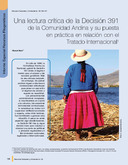Una lectura crítica de la Decisión 391 de la Comunidad Andina y su puesta en práctica en relación con el Tratado Internacional

View/
ISSN
ISSN: 1659-1216Date
04-2008Author
Ruíz, Manuel
Type
Artículo
Metadata
Show full item recordAlternative title
A critical reading of Decision 391 of the
Andean Community and its implementation
in relation to the International Treaty
Description
12 páginas, ilustrado, 1 tabulación, 22 referencias.
Abstract
En 1996, la Comunidad Andina (Bolivia, Colombia,
Ecuador, Perú y Venezuela) fue el primer bloque
de integración regional que aprobó legislación con
respecto al acceso a los recursos genéticos y el
reparto equitativo de beneficios (ABS). A través
de los años, la Decisión 391 sobre un régimen
común de acceso a los recursos genéticos se
ha convertido en un hito y referente importante en
la discusión del ABS. Sin embargo, la puesta en
práctica de esta decisión no ha estado libre de
dificultades, incluyendo los altos costos de transacción e incertidumbre con respecto a su ámbito
y alcance. Con la adopción y la entrada en vigencia del Tratado Internacional sobre los Recursos
Fitogenéticos para la Alimentación y la Agricultura,
los países andinos se encuentran con el reto de
resolver qué normativa es aplicable al acceso a
los recursos fitogenéticos para la alimentación y
la agricultura, especialmente aquellos cubiertos
por el sistema multilateral del Tratado. La Decisión
391 y el Tratado internacional tienen enfoques muy
diferentes en cuanto al acceso y reparto de beneficios, y en la región todavía se está discutiendo si
aplicar las reglas más restrictivas de la Decisión o
el enfoque multilateral, más flexible, ofrecido por
el Tratado. Todo esto en un contexto en el que
todavía no está claro cuál prevalece en términos
de su estatuto legal, si el Tratado o la Decisión
391. El tema es especialmente importante para
los países andinos, porque Perú y Colombia son
anfitriones de dos grandes centros internacionales: el Centro Internacional de la Papa (CIP) y el
Centro Internacional de Agricultura Tropical (CIAT).
Este artículo discute y explora algunos de los
temas relacionados con la puesta en práctica y
la aplicabilidad de la Decisión 391 y del Tratado
Internacional. The
Andean Community (Bolivia, Colombia, Ecuador,
Peru and Venezuela) was the first regional orga nization to pass legislation regarding access to
genetic resources and benefit-sharing (ABS) in
1996. Decision 391 on a Common Regime on
Access to Genetic Resources has become an
important milestone and reference in the debate
regarding ABS. However, the implementation of
Decision 391 has not lacking difficulties and prob lems, including considerable transaction costs and
uncertainties regarding its scope and ambit. With
the adoption and entry into force of the International
Treaty on Plant Genetic Resources for Food and
Agriculture, Andean countries are facing new chal lenges regarding the conditions for accessing
plant genetic resources for food and agriculture,
especially those covered by the multilateral system
of the Treaty. Decision 391 and the International
Treaty have very different approaches regarding
access and benefit sharing, and debates are still
ongoing in the region as to whether to apply the
more restrictive rules of the Decision or the more
flexible, multilateral approach offered by the Treaty.
All this, in a context where it is still not clear whether
the Treaty or Decision 391 prevail in terms of
their legal status. This is additionally important for
Andean countries, given that Peru and Colombia
are hosts to two important international centres:
the International Potato Center and the International
Centre for Tropical Agriculture. This article explores
some of the issues and debates surrounding the
implementation and applicability of both Decision
391 and the International Treaty.
Keywords
Publisher
CATIE, Turrialba (Costa Rica) CATIE, Turrialba (Costa Rica)


